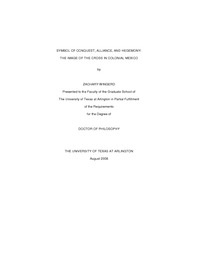| dc.contributor.author | Wingerd, Zachary | en_US |
| dc.date.accessioned | 2008-09-17T23:35:00Z | |
| dc.date.available | 2008-09-17T23:35:00Z | |
| dc.date.issued | 2008-09-17T23:35:00Z | |
| dc.date.submitted | July 2008 | en_US |
| dc.identifier.other | DISS-2164 | en_US |
| dc.identifier.uri | http://hdl.handle.net/10106/1057 | |
| dc.description.abstract | The universality of the cross image within the transatlantic confrontation meant not only a hegemony of culture, but of symbolism. The symbol of the cross existed in both European and American societies hundreds of years before Columbus. In both cultures, the cross was integral in religious ceremony, priestly decoration, and cosmic maps. As a symbol of life and death, of human and divine suffering, of religious and political acquiescence, no other image in transatlantic history has held such a perennial, powerful message as the cross. For colonial Mexico, which felt the brunt of Spanish initiative, the symbol of the cross penetrated the autochthonous culture out of which the independent nation and indigenous church were born. | en_US |
| dc.description.sponsorship | Richmond, Douglas W. | en_US |
| dc.language.iso | EN | en_US |
| dc.publisher | History | en_US |
| dc.title | Symbol Of Conquest, Alliance, And Hegemony: The Image Of The Cross In Colonial Mexico | en_US |
| dc.type | Ph.D. | en_US |
| dc.contributor.committeeChair | Richmond, Douglas W. | en_US |
| dc.degree.department | History | en_US |
| dc.degree.discipline | History | en_US |
| dc.degree.grantor | University of Texas at Arlington | en_US |
| dc.degree.level | doctoral | en_US |
| dc.degree.name | Ph.D. | en_US |
| dc.identifier.externalLink | https://www.uta.edu/ra/real/editprofile.php?onlyview=1&pid=1214 | |
| dc.identifier.externalLinkDescription | Link to Research Profiles | |

